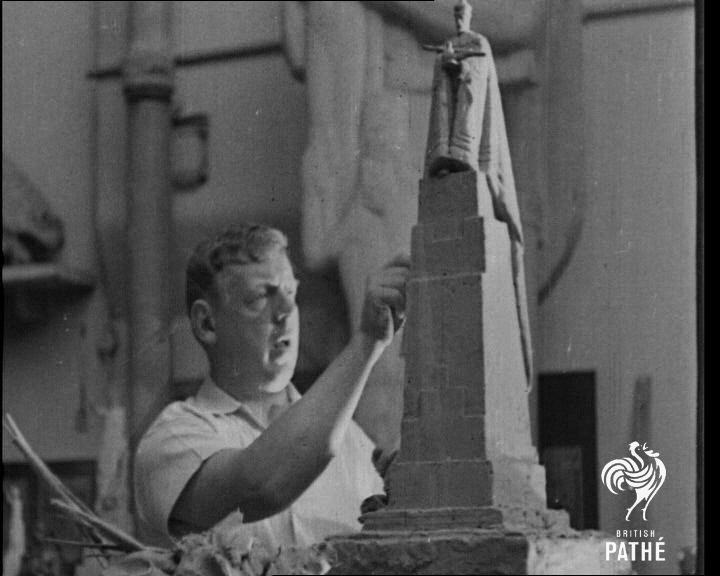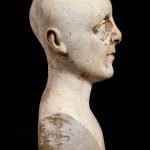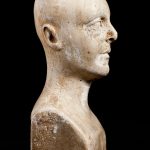Coming home – Bally’s miniature phrenological specimens
Article DOI: https://dx.doi.org/10.15180/140102
Abstract
The arrival of William Bally’s set of miniature phrenological specimens in Manchester for the Wellcome Collection exhibition Brains: The Mind as Matter (26 July 2013 – 4 January 2014) was an ideal time to reassess the mysteries of its production – was it made in Manchester or Dublin? In what context was it produced? Phrenology – the study of the shape and contours of the skull to determine mental faculties – has received attention from historians. But the origin and context of this object, although long part of the canon of 19th-century phrenology, has never been fully explored. Close inspection of the object has enabled analysis of its place in the career of its maker, and its significance today as evidence of the role of material culture in the practice of 19th-century phrenology.
Keywords
Johann Spurzheim, Manchester, material culture, phrenological busts, phrenological heads, phrenology, William Bally
Introduction
https://dx.doi.org/10.15180/140102/007A set of 60 small plaster busts, each with a different form – shape, size and features – has long been one of the treasures of the Science Museum’s The Science and Art of Medicine gallery (see Figure 1). In the 19th century they were referred to as ‘Bally’s phrenological specimens’, a tool used by William Bally in his practice of phrenology. Said to be made in Manchester in 1831, the set was collected by the Wellcome Historical Medical Museum in 1951, and put on display at the Science Museum in the late 1970s. Then, when the set was requested for loan to the Wellcome Collection exhibition Brains: The Mind as Matter at the Museum of Science & Industry in Manchester, it seemed exciting to think that it was coming home after almost 200 years away. But research has uncovered that this neat story of origin and return is very possibly untrue. The signs were there – the object has always been catalogued as ‘possibly Manchester or Dublin’. When initial research revealed that the maker, William Bally, was in Manchester during the 1830s, the ‘coming home’ story gained momentum.
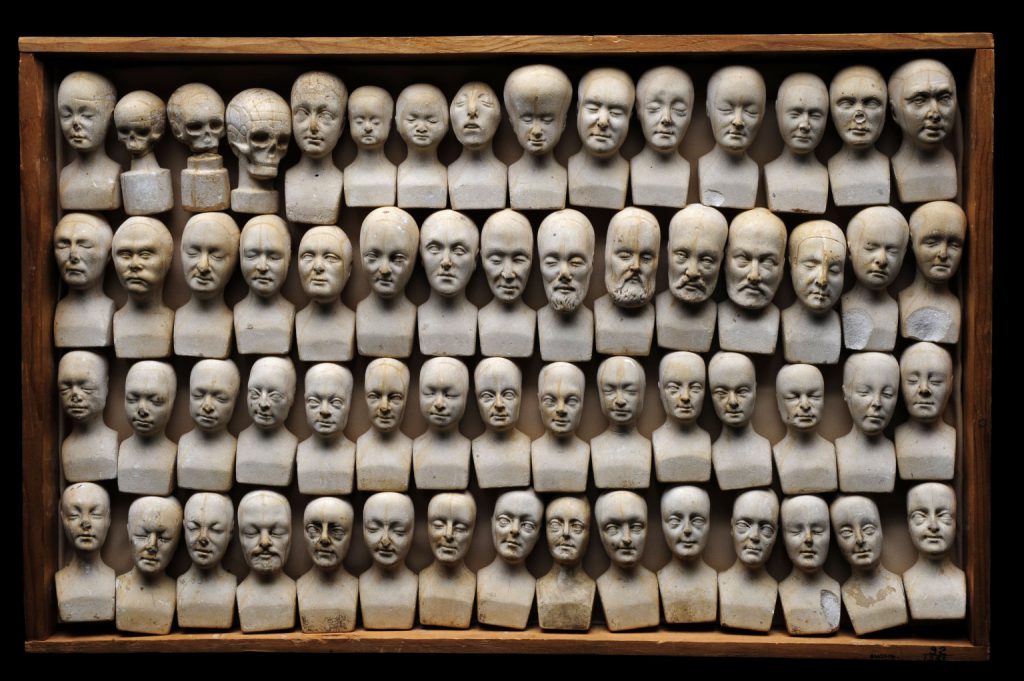
Using close inspection of the object, and a re-examination of the primary literature surrounding William Bally and his phrenological practice, it has been possible to determine that the set was in fact made in 1832, and that Bally’s career as a phrenologist probably began with this set of miniature busts. Historian Roger Cooter has cited the busts in his comprehensive Phrenology in the British Isles (Cooter, 1989, p 313), but this is the first time that the context of their production has been considered, both in terms of the importance to Bally’s career as a phrenologist, and the importance of material culture to the practice of phrenology in the 19th century. Nevertheless, whether the set of miniature busts was made in Manchester or Dublin remains a matter of speculation.
Mr William Bally, artist
https://dx.doi.org/10.15180/140102/008William Bally was born in Locarno, Switzerland in 1796 (anon., 1858b). It is widely acknowledged that he travelled with the phrenologist Johann Gaspar Spurzheim between 1829 and 1831. Spurzheim had been a pupil of Franz Joseph Gall, before he travelled to England in 1813, and lectured on tour between 1814 and 1831 (Cooter, 1989, p 310). The Phrenological Journal and Miscellany reported in 1832 that ‘Mr William Bally, artist’ had produced a set of 60 phrenological specimens under the direction of Spurzheim (anon., 1832; see also Love, 1839, p 119). The busts were each ‘about three inches high’, and were accompanied by a printed description prepared by Dr Spurzheim. The busts were thus a collaboration between the two men: Bally as the artist, Spurzheim the phrenologist.
On examination now, each of the busts is around 7.5 cm tall by 3.5 cm wide, with a depth of about 4 cm, depending on the size of the head and nose. They are made of solid plaster, and were probably finished with an animal glue or rabbit skin size (or wash), traces of which are found around the eyes, nose and ears of some of the busts (see Figure 2). There are brush marks on the surface of the plaster, suggesting that a smooth and blemish-free finish was not required (see Figure 3). Each bust is marked with its number in the sequence, from 1 to 60, scored into the reverse. Bust 1 also carries the identifying inscription ‘By Wm Bally 1832’ on its reverse (see Figure 4). Many have a shiny dot of pigment on the back of the head – at the point at which it makes contact with the wooden box – perhaps a shellac polish from a previous box.

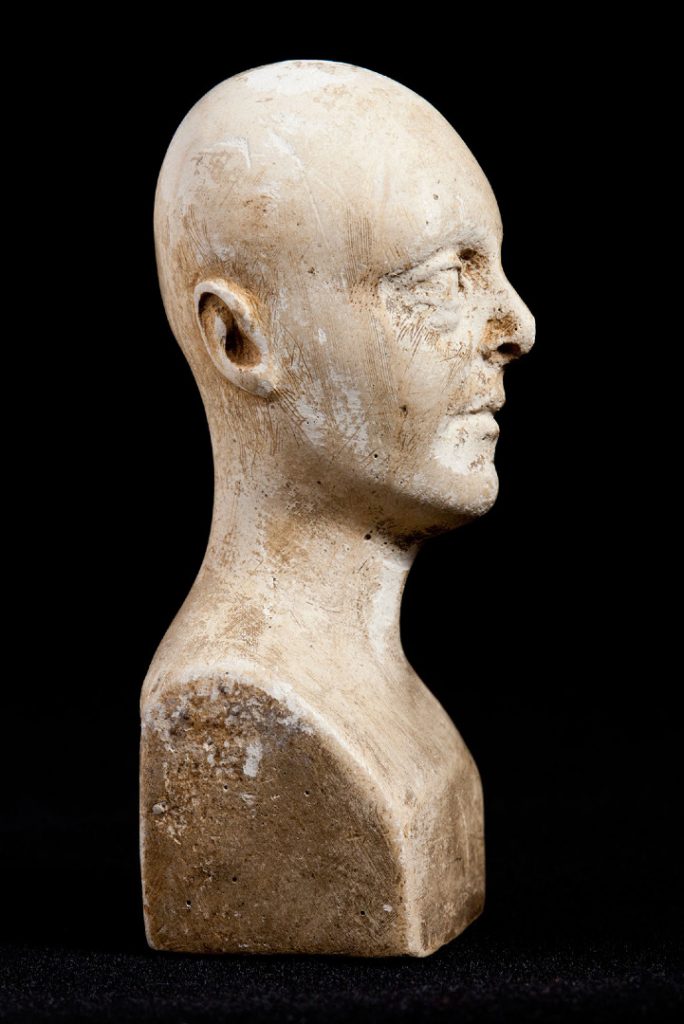

The busts were probably scaled down from plaster casts of the head, or profile drawings made by pantograph. Bally’s technique for making a cast of the head was described in 1845:
‘The person is made to recline on his back, at an angle of about 35 degrees, upon a seat ingeniously adapted to the purpose. The hair and face being anointed with a little pure scented oil, the plaster is laid carefully upon the nose, mouth, eyes, and forehead, in such a way as to avoid distorting the features … The plaster is then applied to the parts of the head still uncovered, and soon afterwards the mould is hard enough to be removed in three pieces … We greatly admired the skill and quickness with which Mr Bally performed the operation.’ (anon., 1845b, p 98)
Casts could be made from life – in which case a hole was left for the subject to breathe – or postmortem as death masks. Some of the specimens in the set have their eyes closed, some open – which might suggest those made from life, and those from death masks. Number 8 is the only bust to have teeth showing. Numbers 24 to 27 have moustaches and beards (Figure 5).
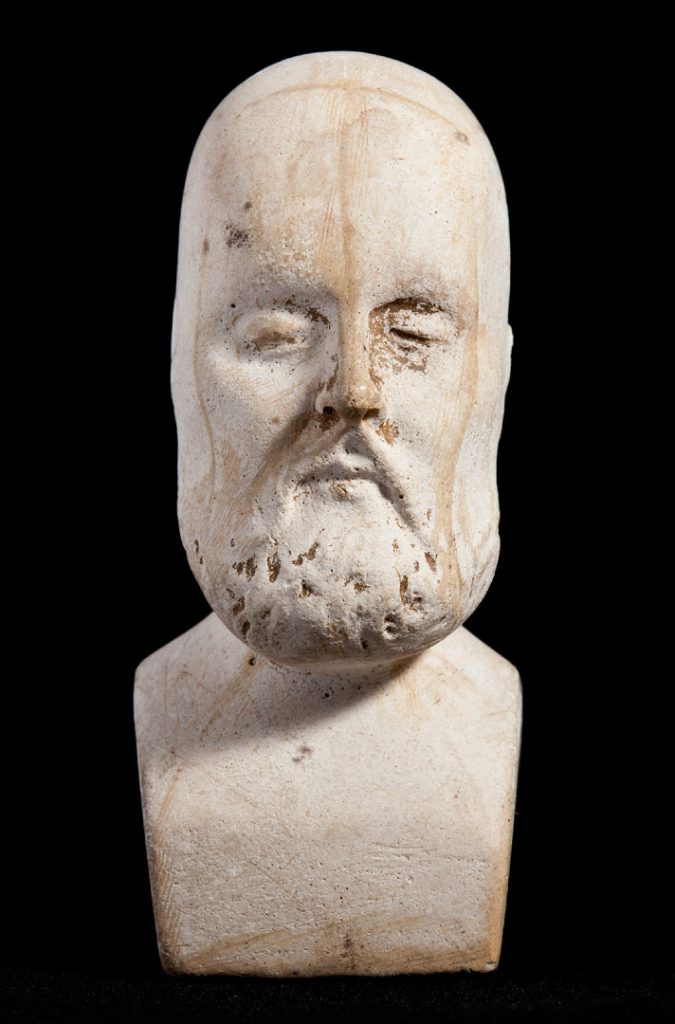
We know that Bally was making casts in the early 1830s because he published Mons. Bally’s Lectures on Casting, Modelling, &c. in around 1833 (Bally, c. 1833). Taking a cast of the head from a living subject, ‘so as to form a mould, preparatory to building a bust in plaster’ was the third in Bally’s series of five lectures (ibid., p 6). Details of technique were not supplied in the eight-page booklet, however, since ‘they must be seen and carefully attended to, for the purpose of being fully understood’ – a means of generating a paying audience for his lectures (ibid., p 7). The series also covered the casting of medals and coins, fruit, leaves and flowers, and anatomical preparations, thereby appealing to antiquaries, ornamental plasterers and the medical profession. Contemporaries also stated that Bally made casts for Spurzheim (Edmondson, 1836, p 634).
The technique of making profile drawings by pantograph was well known to statuaries and stone masons (see this British Pathé film from 1935)[1].
Bally’s use of the pantograph is recorded in a review of an exhibition held at the Manchester Mechanics’ Institution in 1842–43, where for the price of one shilling he would take ‘phrenological outlines’ (anon., 1843a, p 16). He also employed the technique to produce outlines of criminals for phrenological comparison (anon., 1842).
As a sculptor, Bally receives entries in biographical dictionaries (such as Mapping Sculpture and the online database of the Henry Moore Institute), [2] and at least two of his portrait works can be traced. A small white wax portrait of John Scott, Earl of Eldon (and Lord Chancellor), is in the collections of the V&A[3] and a marble portrait bust of the Greater Manchester calico printer Salis Schwabe is located at the Old Grammar School, Middleton[4] But the production of the miniature phrenological heads in 1832 was the start of his career as a phrenologist.
Mr William Bally, practical phrenologist
https://dx.doi.org/10.15180/140102/009Bally visited a whole host of British towns and cities on his phrenological tour with Spurzheim. According to a brief biography of Spurzheim, written shortly after his death, the list included Derby, Nottingham, Sheffield, Wakefield, Leeds, Liverpool, Belfast and Bath (Spurzheim, 1833b, pp 94–100). They visited Manchester in October 1829, where Spurzheim examined criminals at the prison, and visited Dublin twice: in April 1830 and April 1831 – this being the last stop before Spurzheim travelled on to Paris. Bally’s whereabouts between 1831 and 1834, when he is then mentioned as having rooms on Oxford Street, Manchester (anon., 1834), are as yet unknown. Did he stay in Dublin, and produce the miniatures there? The earliest copy of the catalogue for the specimens was published in Dublin in 1831 (Spurzheim, 1831). Or was he in Edinburgh, where George Combe was popularising phrenology, and a set of busts and the 1831 catalogue are within the university’s collections?[5] The Edinburgh set is almost identical except in one regard – the number is scored on the front of the bust, in a smaller and more decorative font. Further sets are in the collections of Johns Hopkins University, Baltimore, and the Kulturen museum, Sweden (Blackburn, 2004; Kulturen museum inv. no. KM 85132). Bust 5 of the Baltimore set carries an inscription approximating ‘By Willm B’ with the date 1831, and the numbers are on the reverse, matching the font of the Science Museum set. The busts are however almost 1.5 cm taller.
Given that these busts are dated 1832, perhaps Bally was in Boston, where Spurzheim died that year, and where the 1832 version of the catalogue was published (Spurzheim, 1832)? This seems unlikely as there is no evidence of Bally continuing the tour beyond 1831 or outside the UK. The 1832 catalogue also lists bust 1 as ‘the skull of a man’ (ibid., p 3), while this bust is a head. A third catalogue, published in Nottingham in 1833, has ‘a female head’ for bust 1, and might suggest Bally could have been there in 1832 (Spurzheim, 1833a, p 3). His lectures on casting and modelling, mentioned above, were also published in Nottingham, c. 1833. The most certain reference to his whereabouts during this period is in advertisements for his lectures in Manchester in 1833, where he is described as ‘Mr. Bally, of Liverpool’ (anon., 1833a and b).
A further complicating factor in relying on the inscription for the date of origin is the likelihood of sets having become mixed over time. Bust 9 of the Edinburgh set does not have a number on the front. The set also has three busts missing. The Baltimore set is missing numbers 1 to 4 and 17. The Science Museum’s collections contain another single bust, marked ‘5’, which has been accessioned separately (Object No. A642800). Given that bust 5 of the Baltimore set carries the name and date inscription, and busts 1 to 4 are missing, perhaps these inscriptions were made later, and not even by Bally?
What we can trace is Bally’s growing business as a ‘practical phrenologist’ in Manchester, and the likely importance of such material culture to his practice. When the Phrenological Journal reviewed the set c. 1832 it described its purpose as a teaching tool: ‘Many individuals complain of want of opportunity of acquiring practical skills in observing development, and to such persons these specimens will be found a very valuable acquisition’ (anon., 1832, p 285). This did not just apply to aspiring phrenologists – Bally was very keen to instruct mothers and governesses, in order for them to understand and control their children’s character and abilities (see for example anon., 1842). Perhaps, like many of his contemporaries, Bally saw in phrenology the potential for social reform. The Phrenological Journal considered the set of specimens to be ‘the most valuable contribution which has been made to the science for several years’ (anon., 1832, p 285). This was repeated in Bally’s preface to the 1833 catalogue, where he added, ‘The Artist begs, as it has been a work of great study and labour, for no one to allow copies to be taken, as he himself is the sole proprietor’ (Spurzheim, 1833a, p 2). The set was thus both a teaching tool and Bally’s professional status symbol. It was also a means of generating income – in the sale of the set exclusively by him for the price of two guineas, and in its demonstration in lectures, for which entry fees were charged.
By 1836, Bally was appointed curator of the Manchester Phrenological Society, and was amassing a collection of casts that were used by phrenologist George Combe for his lectures in Manchester in 1837 (anon., 1836, p 263; anon., 1837, p 631). George Combe had been drawn to phrenology after hearing Spurzheim lecture in Edinburgh and, like Spurzheim, discovered the power of the scientific prop. As Roger Cooter has remarked, ‘In the lecture halls the scientific expertise and supposed objectivity of phrenology was visibly reinforced by the very artefacts of medical science – the skulls, busts, casts, and charts of brains with which lecturers surrounded themselves’ (Cooter, 1984, pp 75, 108). The Manchester Phrenological Society had purchased 210 casts of heads in its first year of existence (1829–30), copies of the entire collection of the Edinburgh Phrenological Society, founded by George Combe and colleagues in 1820. To this, Bally had added further purchases and his own castings of the brain (Love, 1839, pp 115–16). Until the late 1830s, meetings of the society were held in rooms underneath Bally’s premises (ibid., p 116).
Bally’s casts of brains, including the ‘mechanical brain’ – a cast of the head and brain of a 15-year-old, divided into several pieces that could be taken out separately (anon., 1834) – demonstrate his access to postmortems. He also had access to patients, and criminals, from whom he took life casts, most likely because of his connections with surgeons active in the Phrenological Society, such as Daniel Noble, the society’s president between 1835 and 1838 (anon., 1836, pp 261, 263; Cooter, 1984, p 95).
Bally’s most productive decade was the 1840s. The fourth exhibition at the Manchester Mechanics’ Institution in 1842–43, in which Bally had a ‘Phrenological Portrait Room’, was attended by over 100,000 people (anon., 1843a, pp 16–17; anon., 1843b, p 20). The following year, the collection occupied the whole of the upper-floor gallery, comprising ‘many thousand casts, masks, and busts’ (anon., 1844). The exhibitions were held to raise funds for the institution, and side shows (such as Bally’s pantograph portraits) were a popular add-on (Tylecote, 1974, pp 73–4). Phrenology classes had been held in the institution since the early 1830s (Cooter, 1984, p 354, note 84).
In 1844, Bally took a cast of John Dalton’s brain, having arrived at the autopsy too late to take a death mask (anon., 1845a, pp 53–4). Dalton was the doyen of Manchester’s scientific community – president of the Literary and Philosophical Society between 1817 and 1844 – and 40,000 people had filed past his body lying in state at the town hall (Kargon, 1977, pp 41–2).
But Bally was not just producing phrenological specimens for others to interpret and study. He was also performing phrenological analysis. Validating his experience during a ‘phrenological lesson’ delivered at the Athenaeum in 1842, Bally claimed to have examined the heads of ‘more than 600 thieves, murderers and other criminals’ (anon., 1842). Advertisements in the Manchester Guardian, very often on the front page,advised of his studio location and opening hours for phrenological consultations (see for example anon., 1849). A ‘phrenological reading’ of Mr Thomas Noton, a relative of Salford-based foundry owner Michael Noton, survives in the Science Museum Library & Archives (Bally, 1848). Dated ‘Apr. 29, 1848’, the printed proforma is annotated to indicate the size of the phrenological ‘organs’ – cautiousness, and the perception of size, locality and time all being particularly large, and thus ‘naturally most powerful and most prone to action’. The printed proforma, with the date 184-, suggests that Bally produced a great number of readings in this decade.
These activities demonstrate that Bally was firmly positioned in the city as a phrenologist. Many itinerant phrenologists did not succeed (Cooter, 1984, p 154). Bally’s collection of casts was reaching thousands of visitors – his clients for phrenological readings included local figures such as Thomas Noton – and he had access to the heads and brains of some of the most famous, and notorious, members of Manchester society. The Manchester Guardian declared him to be ‘one of the best practical phrenologists and manipulators in England’ (anon., 1842). How much of his success as a phrenologist was due to the Manchester milieu?
Mr William Bally, Manchester man
https://dx.doi.org/10.15180/140102/010We can only speculate on Bally’s reasons for settling in Manchester. Perhaps he was attracted to the business opportunities of this bustling industrial city. Manchester’s rapid population growth was attributable to economic opportunities, and in the 1830s immigrants to the city accounted for more than half of this growth (Kargon, 1977, p 2). Newly connected to Liverpool (and the world) by the Liverpool and Manchester Railway, and a city of wealthy industrialists vain enough to commission portraits, it was fertile ground for an artist and sculptor. Or perhaps Bally was optimistic about his chances of making his name as a phrenologist. The Manchester Phrenological Society had been founded in 1829, following those already established in Edinburgh, London, Wakefield and Liverpool. Perhaps the society was young enough to need enthusiastic members, especially those whose products had been recommended by the Phrenological Journal.
Bally had studios in areas likely to pick up trade – affluent King Street, and in proximity to the merchant Exchange (where phrenological lectures were also given) and Strangeways Prison (see for example anon., 1850a, 1852 and 1853). Between 1848 and 1852, he took absences from the city, informing his clients of his departure and return (see for example anon., 1850b and 1852). The Manchester Guardian suggested it was ‘his great attachment to English manners and habits, and to his Manchester friends, [that] soon brought him back’ (anon., 1858b). Now aged in his early fifties, Bally had deteriorating health. In December 1850 the Manchester Guardian reported that he had suffered his third paralytic stroke (anon., 1850c). Six months later, in an article entitled ‘The danger of modelling in wax’, The Times gave full details of his incapacity (anon., 1851a). The toxic substances in coloured wax had caused paralysis of his hands and arms, and extensive ulceration of his throat. ‘The white wax, for instance, contains white lead; the green, copper; the yellow, chrome yellow; the orange, chrome yellow and vermillion – strong poisons all,’ it reported. He had experienced ‘intense sufferings, for very many years past’, and at times been ‘completely paralysed’. He and his medical adviser concluded that the poisons had been absorbed through the pores of his hands and ‘the occasional application of his fingers to his lips while at work’. Despite his illness, Bally seems to have participated in the Great Exhibition of 1851, listed in the catalogue as ‘Inventor and Manufacturer’ (anon., 1851b, p 831). He took just one piece: ‘Busts in miniature, in illustration of phrenology’.
The year 1852 saw his full-time return to Manchester, ‘in better health’, resuming his phrenological instructions from premises near Strangeways Prison (anon., 1852). He moved back towards the Exchange in the following years, and in 1853 produced the bust of Salis Schwabe, as described above (anon., 1853). From December 1855, however, Bally began to practise from his home in Tamworth Street, Hulme (anon., 1855). This probably coincided with a further deterioration of his health, which left him confined to his bed by the end of the following year.
The strength of William Bally’s rank and reputation in Manchester is evidenced by the welfare fund that was established for his benefit. Beginning in 1850 and continuing until his death, leading men and women of Manchester contributed by subscription, raising hundreds of pounds (Willert, 1858; anon., 1858a). Anna Maria Matilda Bally, his wife, died in February 1856 (anon., 1856), and on 8 November 1858, William Bally died, and was buried at St Wilfrid’s Roman Catholic Chapel in Hulme (anon., 1858b). As requested, his coffin contained the death mask of his wife.
Conclusions – coming home?
https://dx.doi.org/10.15180/140102/011Bally’s phrenological collection had long been sold in shares ‘for the public use and benefit’, destined for the proposed free museum of Manchester (anon., 1858c). It had been temporarily deposited at the Mechanics’ Institution on Cooper Street, and then the Free Library on Lower Byrom Street (ibid.). A few remaining busts were left to Bally’s ‘fellow-countryman and modeller’ Benedetti Lanarto (ibid.).
This is where the trail goes cold. By 1860, the committee of the Free Library had deposited Bally’s collection in the Queen’s Park (Art) Museum in Harpurhey, Greater Manchester (Tedder and Thomas, 1880, p 121), and there does not seem to be any other record of it being there. Was the set of 60 phrenological specimens part of that collection, bequeathed to Lanarto or sold in the period after 1832? Bally had at least one set for display at the Great Exhibition in 1851, but the specimens’ renown within the phrenological community could have resulted in a great number being produced. As a set of 61 busts, including the single additional bust marked ‘5’, this set was acquired by the Wellcome Historical Medical Museum in 1951, from a Mrs Spendlove of Finchley, London (anon., 1855). Where they had been for the previous 119 years remains one of the many mysteries of museum collections.
As so often happens with the close inspection of a museum object, more questions have been generated than answered. Inspection revealed the date made to be 1832, which led to numerous questions about where the set had been made. Comparison with other sets showed similarities and differences in production, but offered no conclusions about place of origin. Scrutiny of the form and finish of the busts led to questions about how the busts had been made. Some of Bally’s techniques were evidenced in the objects, while others were elucidated from the primary literature. Finally, a consideration of the significance of these objects to Bally, and to the phrenological community, again supported by the primary literature, led to conclusions about their key role in Bally’s identity as a phrenologist, and the importance of material culture in the 19th-century practice of phrenology. E McClung Fleming’s model for artefact study, first published in 1974 (McClung Fleming, 1982), suggests these steps: factual description, evaluation by comparison with other objects, analysis of the object’s place in its culture, and its current significance. They remain one of the most useful ways of interrogating objects, although sadly in this case they did not confirm the busts’ emotionally engaging ‘coming home’ story.
Tags
Footnotes
Back to text
Back to text
Back to text
Back to text
Back to text


